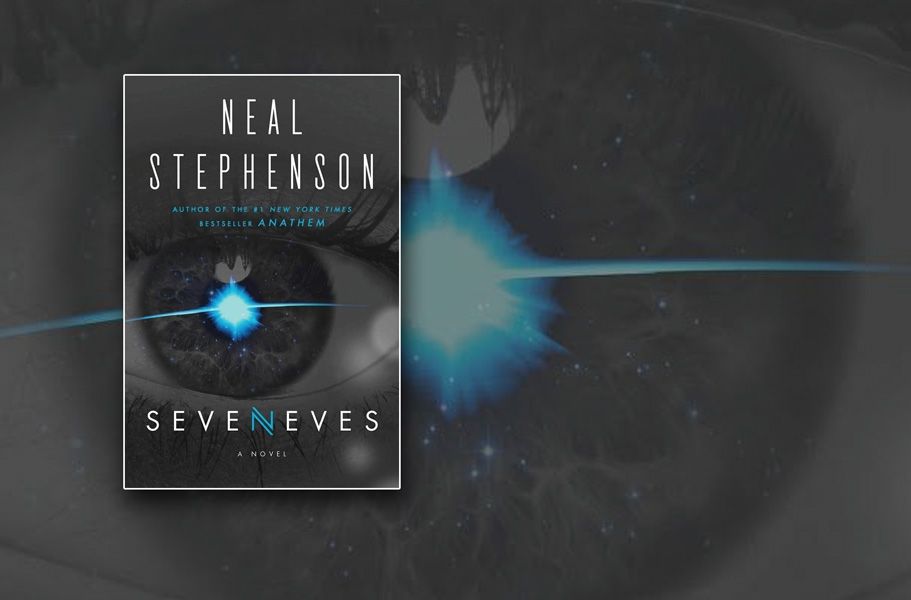At a Douglas Adams book talk I attended near the end of the last century, someone asked the author what advice he had for writers. Adams’s first bit of advice was this: Don’t start a book by blowing up the Earth, which is of course how Adams’ started The Hitchhiker’s Guide to the Galaxy. Neal Stephenson begins his latest novel, Seveneves, by blowing up the moon.[1] The destruction of the Earth follows, but Stephenson gives his large cast of characters a couple of years and hundreds of pages to figure out how they are going to survive this apocalyptic event. Since Stephenson has called for a return to inspiring overarching narratives in science fiction, and his title (“seven Eves”) refers to a symbolically full number of Eves, one should approach this book as one would an ancient apocalypse: with an incredible hope for a beginning in an end.
To escape the coming deluge of fire—the “Hard Rain” caused by the break-up of the moon’s remains—the governments of the world collaborate to build a space ark. Unlike its biblical predecessor, filled with representatives “of every living thing of all flesh,” this “Cloud Ark” will preserve select humans and a comprehensive digital repository of Earth’s genetic and cultural heritage. Instead of forty days, this new ark must transcend any “traditional legacy-passing schemes” and preserve humankind and culture for five millennia until a new Earth can be created. This epic endeavor to extend human life in space and time involves creative and ambitious uses of technologies, which raise questions about the role of technology in human development. How will technology triumph in the struggle against nature? How will human nature evolve outside of its natural or original habitat? What will a substantial dependence on technological expertise and tools, such as robots and computerized control systems, mean for human culture? In such a highly technological culture, what are the inherent or properly imposed limits of technology? Finally, will technology create a new and better Earth?

The hard news about the end of the world as we know it is shared with humanity at Crater Lake, Oregon, where natural and human history reveal a prophetic message “for anyone who wanted to read it”: “Between six and eight thousand years ago, an unimaginable catastrophe had befallen this place…surviving humans had kept the story alive in legends of an apocalyptic struggle between the gods of the sky and of the underworld.” The first sign of hope for humanity in Seveneves is seen in the response of the last generation during what is called the Age of the One Moon, who collectively engage in their own apocalyptic struggle by building out the International Space Station, digitizing everything from genetic sequences to family records, and launching as many people and as much stuff as possible into space. Although only a portion of humanity will survive, everyone is invited to contribute content to “a literary, artistic, and spiritual legacy that would outlive them.” Like members of the childless generation in P. D. James’s apocalyptic novel The Children of Men, many transfer their hope in the future to a record that will survive them. But unlike Michel Faber’s apocalyptic novel The Book of Strange New Things, there is not a total fall into chaos. This reader was comforted to learn that in the latter days “most of the people of Seattle were still obeying [parking] rules.”
Stephenson’s vision of the future, both near and distant mixes continuity and discontinuity. Ancient patterns of human nature, both glorious and inglorious, are present in the struggle for survival. Social media wars continue in space, via Spacebook and Scape; new forms of “techno-mystical ideation” emerge; fights for control of diminishing spheres of influence become increasingly savage; and perplexing records are created for later generations to sort out, reflect on, and interpret. But we also witness the innovation and ambition Stephenson would like to see in our pre-apocalyptic world: “The imperative to develop new technologies and implement them on a heroic scale … to escape from [our] current predicaments.”[2]
Five thousand years into the future, when the descendants of the Seven Eves are ready to return to a remade Earth, humans have evolved to thrive in highly technological environments. And yet, with the accumulated knowledge of Old Earth, and all that has been added to it through millennia of progress and regress, people are still debating the appropriate integration of technology in human life. The term “Amistics,” referring to Amish scruples about certain technologies, is used to describe “choices that different cultures made as to which technologies they would, and would not, make part of their lives.” Among the descendants of the Seven Eves, two distinct cultures exist: one, called “Red,” is “enthusiastic about personal technological enhancement.” The other, called “Blue,” views technological aids “with some ambivalence.” For Blues, “Each enhancement is an amputation.”
Looking backward, Blue culture critiques Old Earthers for focusing “their intelligence on the small and the soft, not the big and the hard” and for building “a civilization that was puny and crumbling where physical infrastructure was concerned, but astonishingly sophisticated when it came to networked communications and software.” At a fundamental and individual level, they observed a common tendency to let personal technologies get in the way of higher faculties and distract from greater achievements. In the canonical video record of the events leading up to and following the end of Old Earth, called “the Epic,” the historical figure who embodied this behavior was Tavistock Prowse. Prowse, who had been sent up to hold the Cloud Ark community together with his social media skills, ended up fueling a rebellion through his blog. When his recorded activities were scrutinized by later generations—“how he had divided his time between playing games, texting friends, browsing Spacebook, watching pornography, eating, drinking, and actually writing his blog”—statistical analysis “tended not to paint a very flattering picture” and Prowse became a cautionary figure:
“Prowse had been squarely in the middle of the normal range, as far as his social media habits and attention span had been concerned. But nevertheless, Blues called it Tav’s Mistake. They didn’t want to make it again. Any efforts made by modern consumer-goods manufacturers to produce the kinds of devices and apps that had disordered the brain of Tav were met with the same instinctive pushback as Victorian clergy might have directed against the inventor of a masturbation machine. To the extent that Blue’s engineers could build electronics of comparable sophistication to those that Tav had used, they tended to put them into devices such as robots.
Stephenson thus presents a future in which new genetically engineered human races live within a sophisticated technological infrastructure above the Earth’s surface, but have not yet matched the storage and network capabilities of five-thousand-year-old smartphones, tablets, and laptops. This vision of technological progress includes technological restraint: old technologies, such as paper books, persist; automation is complemented by human intervention and enhancement; and physical skills are still cultivated and valued. When the action shifts to the surface of New Earth, we discover other Amistic alternatives: those from the sky are not the only ones who have adapted, naturally and technologically. The selections made above, represented in and through the massive digital library and archives in the sky, have terrestrial counterparts below.
Near the end of the book, as histories and narratives collide and the origin story of New Earth takes form, another type of ark appears off a beach. The name of this “complex mechanical” vehicle, Ark Darwin, represents human as well as natural selection and adaption. In On the Origin of Species, Charles Darwin used Francis Bacon as epigraphical cover for his exploration of natural causes to explain natural phenomena. Bacon claimed that one cannot “search too far or be too well studied in the book of God’s word, or in the book of God’s works.”[3] Bacon valued both divine and natural revelation, and was among the first modern natural philosophers to bring scientific discovery and technological work together, making the latter the natural application of the former. Both, Bacon argued, had critical roles in restoring what had been lost in a primordial fall from the original creation. Although Stephenson’s New Earth is rather different from Bacon’s utopian New Atlantis, the two works share a largely optimistic appraisal of scientific and technological dominion over nature.
Like Dave Eggers’s novel The Circle, which says more about “the small and the soft” ends of our personal technologies, Seveneves is hard to classify as utopian or dystopian. The near technological future that Eggers creates is ostensibly utopian (“the dawn of the Second Enlightenment”), but it is far from an ideal place. And although Stephenson’s near and far technological futures could be described as dystopian (with the destruction of the Earth and all), they are not without idealistic characteristics. Both, however, are apocalyptic: not only because they deal with cataclysmic disruptions, but because they open up our perceptions of knowledge, time, space, and community to uncover and reveal something deeper about the ends of these fundamental dimensions of experience. While The Circle remains a work of apocalyptic realism staying close to a material reality familiar to us, Seveneves more radically addresses apocalyptic questions of human understanding, nature, and destiny—and the dependencies of these on technology.
For Bacon, the future redemption of the world depends on much more than human agency aided by science and technology. Without referring to divine revelation, Stephenson also suggests something more. The final scene of Seveneves occurs in an improvised refectory on Ark Darwin, with a discussion of an agency beyond Darwinian natural selection and human technological intervention called “the Purpose.” According to the guesses of a leading character closest to the answer, the Purpose concerns the purpose to the universe. In the millennia-long struggle for life after the moon blew up, he says to new friends with whom he is sharing a meal, there “was surprisingly little thinking about the Agent”—the name given to the unknown cause—“Where it came from. Whether it was natural or artificial, or even divine.” “The Purpose,” he continues, is a way “of saying there’s something bigger than this crap we’ve spent the last week of our lives dealing with.” “I like the feeling of that,” he concludes; “People who claim they are motivated by the Purpose end up behaving differently—and generally better—than people who serve other masters.” Political tensions persist outside Ark Darwin, with armed forces facing off, but at this table an ancient and familiar form of fellowship suggests hope for something greater than an old or new Earth.
Citations[1] Neal Stephenson, Seveneves (New York: William Morrow, 2015). All quotes are from the EPub Edition.
[2] Neal Stephenson, “Innovation Starvation,” available from http://www.worldpolicy.org/journal/fall2011/innovation-starvation.
[3]Francis Bacon, quoted opposite the title page of Charles Darwin, On the Origin of Species by Means of Natural Selection: Or the Preservation of Advanced Races in the Struggle for Life (London: John Murray, 1859).




